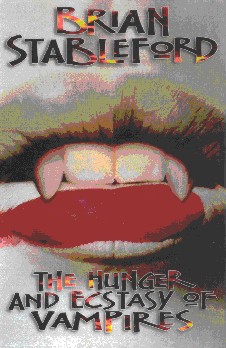Review by Ian Braidwood
Cast of Characters:
Oscar Wilde, Sir William
Crookes, Nikoli Tesla, H.G. Wells, M.P.Shiel, a grey-eyed detective,
Jean Lorrain, Octave Uzzanne, Count Lugard, Professor Edward Coppelstone
and his doctor.
One
night in 1895, three men and their companions are invited to the home
of Professor Edward Coppelstone for dinner and to hear something they
are promised is remarkable.
Since
Coppelstone is a well known traveller and adventurer, this promise
is enough to attract some of London's most notable luminaries:
Sir
William Crookes, a distiguishedmember of the Psychical Society; was
bound to be intrigued and bought scientists Nikoli Tesla. M.P. Shiel,
brought fellow writer H.G. Wells, while Oscar Wilde is accompanied
by a mysterious Eastern European gentleman.
Under
the supervision of his doctor and his mysterious companion, Coppelstone
begins to recount the effects of a formula prepared from many shamanistic
and tribal drugs to gain visions into the future...
I
have come to the conclusion that I hate writing reviews of stories
when I have previously written a review of a longer or shorter version.
It simply doesn't suit what might charitably be called my method,
given that I strenuously avoid giving away the plot.
When
reviewing abridged versions of Brian's stories, it leaves me with
little to say beyond how brief it seems; but that is nothing compared
to the paroxysms I suffer when I consider the extra material introduced
in the long versions.
You
see, Brian has a philosophical bend to his writing, which only really
gets expressed in these longer versions; such as the tension inherent
in any time travel story between determinism and free will. Consider:
To
see something, it must exist. A photograph, be it moving or still,
must be of something even if it masquerades as something else.
So, when Coppelstone takes his draft and has his vision, does the
vision include the fact that it has been foreseen, or does it stop
being the truth because he was able to gain intelligence enough to
prevent it and if so, why doesn't the vision swim into a new possibility?
Oh
yes, it's aspirin time, folks. The prediction business might tell
you the winner of the 5:15 at Kempton Park, but it plays merry hell
with causality, don't you know.
Add
to this the apparent similarities between Coppelstone's vision and
H.G. Wells', which aren't as perplexing as the differences. What is
the relation between Wells' Eloi and Coppelstone's humans of the future?
Could it be that Wells can venture naturally where Coppelstone needs
drugs to go? Is there another explanation?
It
has just occurred to me that this is the only story of Brian's I know
of, which features some form of two way time travel. I'm beginning
to understand why.
If
I might mix some metaphors, this novel is one where you can enjoy
the texture of the paints, as well as the image on the canvas. The
portraiture is so good you can almost taste the claret on Wilde's
lips and feel the heat of Wells' brow, as he comes to suspect plagiarism.
Right now, both versions of this story must count as hard to get, with
the Interzone issue being some time past and the book a limited edition.
Getting either one might count as an achievement, but given the choice,
it's the long version you want.
|


